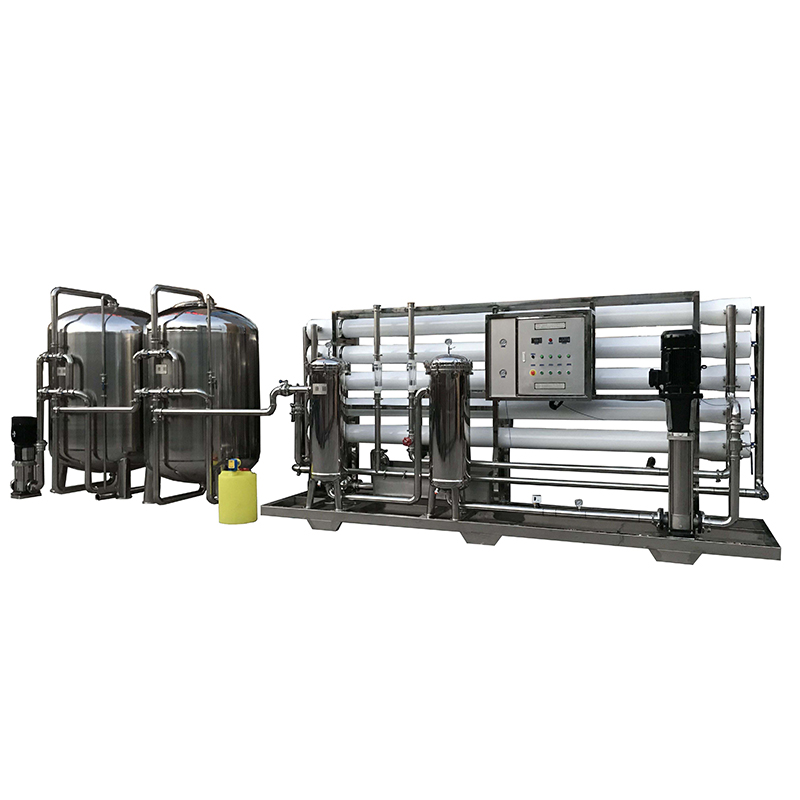10 Ton Ultraviolet Rays Disinfection and Sterilization Fully Automatic Machine
Product description
I. System Composition
- Water Inlet and Pipeline System
- The machine is equipped with a water inlet connection that is designed to receive the water to be treated. The pipeline system is made of suitable materials, such as stainless steel or high-quality plastic, to ensure the integrity of the water flow and prevent contamination. The pipeline is sized to handle a flow rate of 10 tons per hour.
- Valves are installed along the pipeline to control the water flow, including shut-off valves for maintenance and regulating valves to adjust the flow rate as needed.
- Ultraviolet Reactor Chamber
- This is the core part of the machine. The reactor chamber contains ultraviolet lamps, which are usually low-pressure or medium-pressure mercury lamps. These lamps emit ultraviolet light in the germicidal wavelength range (around 254 nm for low-pressure lamps), which can effectively destroy the DNA or RNA of microorganisms, such as bacteria, viruses, and protozoa, rendering them unable to reproduce and thus achieving disinfection and sterilization.
- The chamber is designed to ensure that the water has sufficient contact time with the UV light. It may have a specific internal structure, such as baffles or flow distributors, to evenly distribute the water and maximize the exposure to the UV rays.
- UV Lamp Monitoring and Control System
- Sensors are installed to monitor the operation of the UV lamps. These sensors can detect parameters such as lamp power, lamp life, and UV intensity. If the UV intensity drops below a certain level, indicating a possible problem with the lamp (such as aging or malfunction), the control system will issue an alarm.
- A programmable logic controller (PLC) or a similar control device is used to manage the operation of the UV lamps. It can automatically turn the lamps on and off according to the water flow signal. For example, when water starts flowing through the system, the PLC will activate the UV lamps, and when the water flow stops, the lamps will be turned off to save energy.
- Automatic Cleaning System (Optional)
- Over time, the UV lamps and the internal surfaces of the reactor chamber may accumulate fouling, which can reduce the effectiveness of the UV disinfection. An automatic cleaning system can be included to address this issue.
- This may involve a wiper mechanism that periodically cleans the outer surface of the UV lamps to remove any deposits. In some cases, a chemical cleaning system may be used to clean the internal surfaces of the reactor chamber at regular intervals.
- Water Outlet and Monitoring Devices
- The treated water exits the machine through the water outlet. There are sensors installed at the water outlet to monitor the quality of the treated water, such as turbidity sensors and microbiological sensors (although direct measurement of microbiological content in real-time may be challenging and is often done through periodic sampling and laboratory analysis).
- Flow meters are also present at the water outlet to accurately measure the actual water flow rate and ensure that the machine is operating at the designed capacity of 10 tons per hour.
II. Working Principle
- Water enters the machine through the water inlet and flows into the ultraviolet reactor chamber.
- As the water passes through the chamber, it is exposed to the ultraviolet light emitted by the lamps. The UV light penetrates the cells of microorganisms and damages their genetic material, preventing them from reproducing and effectively sterilizing the water.
- The UV lamp monitoring and control system continuously monitors the operation of the lamps. If any issues are detected, such as a lamp failure or a decrease in UV intensity, the system will take appropriate actions, such as sounding an alarm or shutting down the machine for maintenance.
- The automatic cleaning system, if available, periodically cleans the UV lamps and the internal surfaces of the reactor chamber to maintain the efficiency of the UV disinfection process.
- The treated water then exits the machine through the water outlet, and the quality of the water is monitored using the sensors installed at the outlet.
III. Applications
- Municipal Water Treatment: It can be used in small to medium-sized water treatment plants to disinfect the water supply before it is distributed to households and industries. This helps to ensure the safety of the drinking water by removing harmful microorganisms.
- Industrial Water Treatment: In industries such as food and beverage, pharmaceuticals, and electronics, where high-quality water is required, the UV disinfection machine can be used to sterilize the process water, preventing contamination of products and ensuring compliance with strict quality standards.
- Swimming Pool and Spa Water Treatment: To keep the water in swimming pools and spas clean and free from bacteria and viruses, UV disinfection can be an effective and chemical-free alternative or complement to traditional chlorination methods.
- Wastewater Treatment: In some cases, UV disinfection can be used in the final stages of wastewater treatment to reduce the microbial load in the treated effluent before it is discharged into the environment.
Write your message here and send it to us










